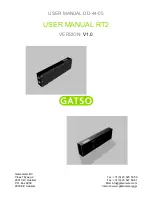
This document is the property of KYMATI GmbH and must not be copied or disclosed without its written authorisation.
- KYMATI GmbH – 2021
KY.MAN.0105 (6.0)
KY-LOC 1D.02.01 User Manual
Doc.- No.: KY.MAN.0105
Version:
6.0
Date:
14.12.2021
Page:
32 of 83
It is only possible to configure the devices the Ethernet Interface. The devices
may be connected separately or at the same time to configure them. This can
be done before installation.
6.4
Connect to the System
After the sensors are powered, it will start automatically. The master will start sending out a
signal and the slave tries to synchronize to that signal. This can take up to 30 seconds. If the
devices are synchronized, they start measuring the distance and the LEDs will stop blinking
and illuminate constantly.
6.5
First Run
Before using the system operationally, a reference measurement should be recorded.
Therefore, the system should be running from the minimal distance to the maximum possible
distance and the range and SNR values should be recorded during this movement. Afterwards
the Zero Point should be set. Therefore, the device carrying the moving sensor should drive to
the position were the zero of the measurement should be. At this position, the zero command
should be executed. A pop-up window, on the KYMATI User Interface, is showing if the
command is taken by the radar. Additionally, the user may retrieve the data to make sure that
the zero offset is set properly. While retrieving configuration data the synchronization will be
lost so the users shall wait for the radars to resynchronize.
6.6
Turning off the System
To turn off the sensor, simply switch off the power supply. The status LED and power LED will
turn off. After unintended power cycle, the system will be automatically restarted.
6.7
Anti-Collison
The System has built in an Anti-Collision feature that can raise up to 4 different alarms when
a configurable distance is reached. How to configure the device is described in chapter 9.3
The Anti-Collision feature has two modes which are described below. Each mode can be
configured for a single crane scenario or a double crane scenario:
Fixed Warning Zones:
There is a possibility to select fixed warning zones. This means if the system is measuring a
distance that is smaller than the defined warning zone, an alarm is generated. Fixed warning
zones can be used for single and double crane applications.
Dynamic Warning Zones:
The idea for the dynamic warning zone is, that a crane may need a relatively large warning
zone if it is traveling at full speed but needs to go close to a dangerous area. This is archived
by increasing the warning zone with the speed of the crane. So, if the crane is traveling at full
speed the warning zone is automatically increased depending on the speed of the crane, this
















































